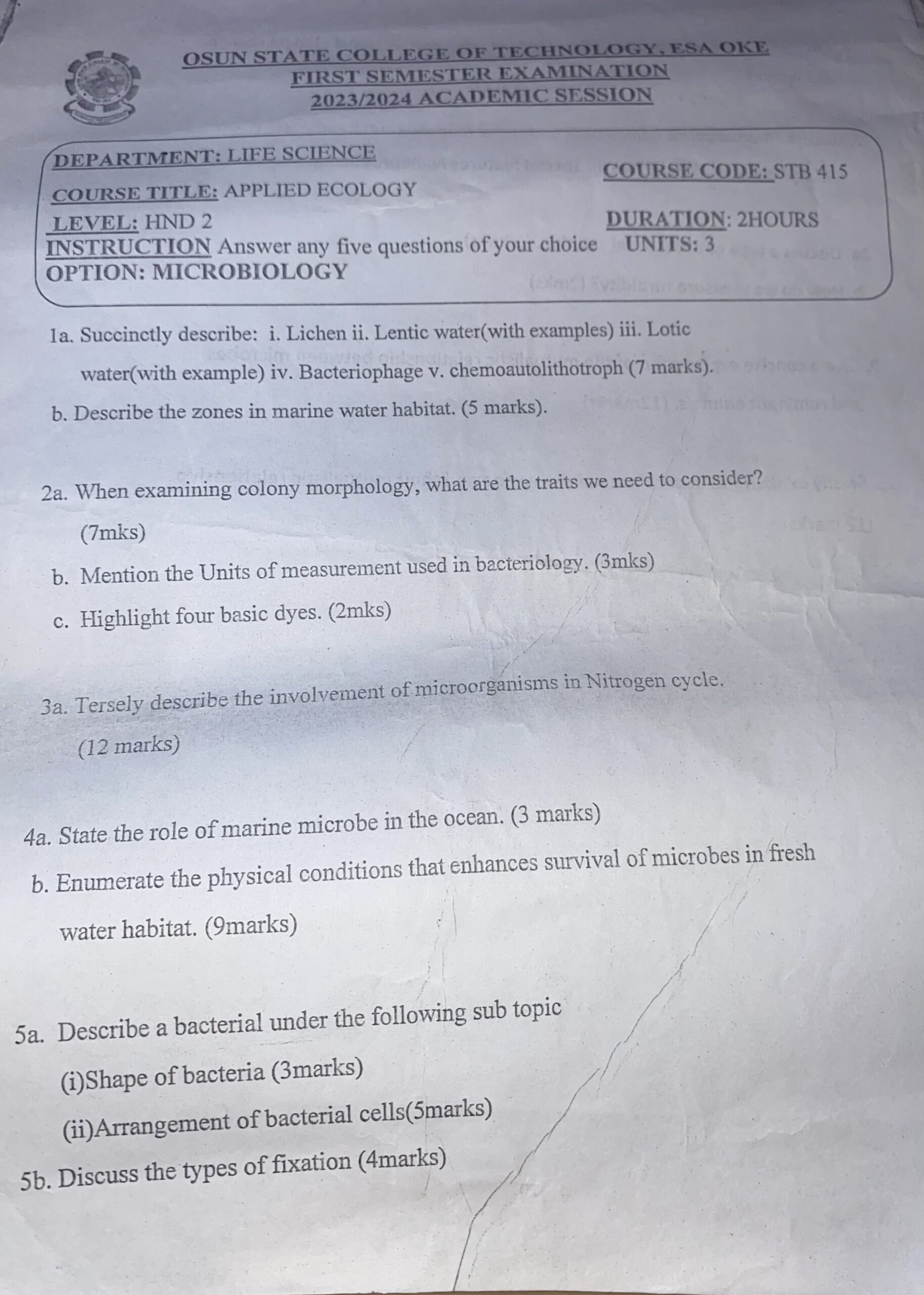OSUN STATE COLLEGE OF TECHNOLOGY, ESA OKE
FIRST SEMESTER EXAMINATION
2023/2024 ACADEMIC SESSION
DEPARTMENT: LIFE SCIENCE
COURSE TITLE: APPLIED ECOLOGY
LEVEL: HND 2
COURSE CODE: STB 415
DURATION: 2HOURS
INSTRUCTION Answer any five questions of your choice UNITS: 3
OPTION: MICROBIOLOGY
Question 1a
i. Lichen
Answer:
A lichen is a symbiotic association between a fungus (mycobiont) and a photosynthetic partner, usually algae or cyanobacteria (phycobiont). The fungus provides structure and protection, while the photosynthetic partner produces food via photosynthesis.
ii. Lentic water (with examples)
Answer:
Lentic water refers to stationary or still freshwater ecosystems. Examples include ponds (e.g., garden ponds) and lakes (e.g., Lake Victoria).
iii. Lotic water (with example)
Answer:
Lotic water refers to flowing freshwater ecosystems. Examples include rivers (e.g., River Niger) and streams.
iv. Bacteriophage
Answer:
A bacteriophage is a virus that specifically infects and replicates within bacterial cells. It consists of genetic material (DNA or RNA) enclosed in a protein capsid.
v. Chemoautolithotroph
Answer:
Chemoautolithotrophs are microorganisms that derive energy by oxidizing inorganic compounds (e.g., hydrogen sulfide, ammonia) and use carbon dioxide as their carbon source.
Question 1b
Describe the zones in marine water habitat.
Answer:
- Intertidal Zone: Area between high and low tide marks, exposed to air and water alternately.
- Pelagic Zone: Open ocean water, divided into neritic (shallow, near coast) and oceanic (deep, open water).
- Benthic Zone: Ocean floor, including sediments and substrates.
- Abyssal Zone: Deepest part of the ocean, characterized by extreme pressure and darkness.
Question 2a
Traits to consider in colony morphology:
Answer:
- Shape: Circular, irregular, filamentous.
- Margin: Entire (smooth), undulate (wavy), lobate.
- Elevation: Flat, raised, convex.
- Color: Pigmentation (e.g., white, yellow).
- Texture: Smooth, rough, mucoid.
- Size: Diameter in millimeters.
- Opacity: Transparent, opaque, translucent.
Question 2b
Units of measurement in bacteriology:
Answer:
- Micrometer (µm): For bacterial cell size.
- Colony-forming unit (CFU): For quantifying viable bacteria.
- Nanometer (nm): For viral particles (e.g., bacteriophages).
Question 2c
Basic dyes:
Answer:
- Crystal violet
- Methylene blue
- Safranin
- Malachite green
Question 3a
Involvement of microorganisms in the Nitrogen cycle:
Answer:
- Nitrogen Fixation: Bacteria (e.g., Rhizobium, Azotobacter) convert atmospheric nitrogen (N₂) to ammonia (NH₃).
- Ammonification: Decomposers (e.g., Bacillus) break down organic nitrogen into ammonium (NH₄⁺).
- Nitrification: Nitrosomonas oxidizes NH₄⁺ to nitrite (NO₂⁻), and Nitrobacter oxidizes NO₂⁻ to nitrate (NO₃⁻).
- Denitrification: Pseudomonas converts NO₃⁻ back to N₂, releasing it into the atmosphere.
Question 4a
Role of marine microbes in the ocean:
Answer:
- Primary Production: Phytoplankton (e.g., Prochlorococcus) perform photosynthesis, forming the base of marine food webs.
- Nutrient Cycling: Degrade organic matter and recycle nutrients like carbon and nitrogen.
- Symbiosis: Provide nutrients to marine organisms (e.g., coral-zooxanthellae symbiosis).
Question 4b
Physical conditions enhancing microbial survival in freshwater:
Answer:
- Temperature: Optimal range for metabolic activity (e.g., 20–30°C).
- pH: Neutral to slightly acidic conditions (pH 6–7.5).
- Oxygen Availability: Aerobic microbes thrive in oxygen-rich zones.
- Light Penetration: Supports photosynthetic microbes (e.g., algae).
- Nutrient Concentration: Availability of organic matter and minerals.
Question 5a
i. Shape of bacteria:
Answer:
- Cocci: Spherical (e.g., Staphylococcus).
- Bacilli: Rod-shaped (e.g., Escherichia coli).
- Spirilla: Spiral or helical (e.g., Spirillum).
ii. Arrangement of bacterial cells:
Answer:
- Diplo: Pairs (e.g., Diplococcus pneumoniae).
- Strepto: Chains (e.g., Streptococcus pyogenes).
- Staphylo: Clusters (e.g., Staphylococcus aureus).
- Tetrads: Groups of four.
- Palisades: Side-by-side rods.
Question 5b
Types of fixation:
Answer:
- Heat Fixation: Passing bacterial smear over a flame to adhere cells to a slide. Used for simple staining.
- Chemical Fixation: Using agents like ethanol or formaldehyde to preserve cell structure. Examples:
- Glutaraldehyde: For electron microscopy.
- Methanol: For Gram staining.


